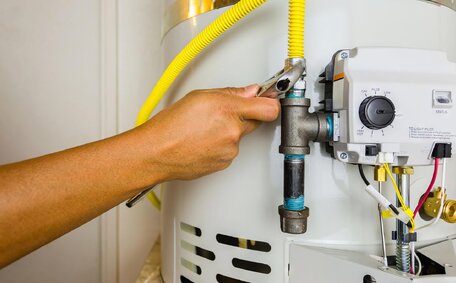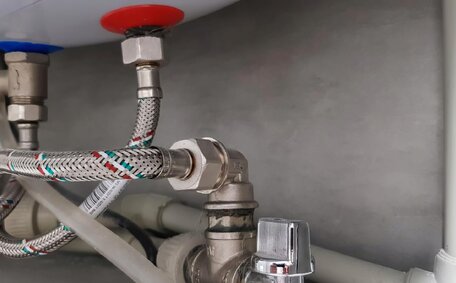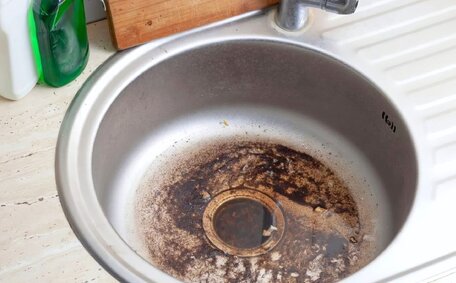Introduction to Pipe Relining
Pipe relining is a trenchless method of repairing damaged pipes without the need for full replacement. Castle Hill Plumbing are experts in pipe relining services for the Castle Hill region and wider Sydney area.
It involves inserting a resin-impregnated fabric tube into the existing pipe and curing it to form a smooth, seamless new pipe lining inside.
Pipe relining can offer numerous benefits over traditional pipe replacement. It is less invasive, with minimal destruction to walls, floors and landscaping.
Projects also take less time, ensuring minimal interruption to your plumbing system’s regular use. The seamless relined pipes are durable, with an expected lifespan matching that of new pipes. Considering pipe relining costs, it is an affordable and effective solution for restoring damaged drainage and sewer pipes.
Understanding the Pipe Relining Process and Timeline
The pipe relining process typically involves five key stages:
- Initial CCTV inspection - A camera is navigated through your pipes to pinpoint any damage or blockages. This takes around 1 hour.
- Relining pipe preparation involves thorough cleaning, which takes 1-2 hours.
- Resin tube installation - The custom-fitted resin tube is inserted into the pipe and inflated to fit tightly. This takes around 1 hour.
- Curing with hot water or steam - Hot water or steam is pumped inside the tube to cure the resin and harden. Curing times vary based on pipe material and size, but often take 1-2 hours.
- Final CCTV check - A final CCTV inspection ensures a smooth and seamless pipe lining installation. This takes around 30 minutes.
The full pipe relining process usually takes between 4-6 hours from start to finish. However, with adequate equipment and experienced technicians, jobs can sometimes be completed within 2 hours. How long does pipe relining last? It is expected to extend your pipe system’s lifespan by 50+ years, ensuring a long maintenance-free duration.
Step-by-Step Procedure for Pipe Relining
The step-by-step pipe relining procedure is as follows:
- Start with a detailed CCTV pipe inspection to identify areas of damage or blockages.
- Thoroughly clean the pipes with high-pressure water jetting to remove debris and prepare the surface.
- Prepare resin by mixing it to the correct ratios and pouring it into the felt liner tube.
- Insert the resin-saturated liner into the damaged pipe, either by pulling or inflating into place.
- Apply heat or steam to cure the resin and harden it, bonding it securely to the pipe interior.
- Once cured, trim excess material and reconnect lateral joins and connections if required.
- Conduct final CCTV inspection to ensure a smooth, seamless pipe lining installation.
Pipe relining can repair damaged pipes from the inside through a non-invasive, trenchless method. It uses advanced CIPP (cured-in-place pipe) technology and resin materials to essentially create a 'pipe within a pipe’ with strength and longevity matching new pipes.
Key Factors Affecting Pipe Relining Project Duration
There are several key factors that can affect the total time required to complete a pipe relining project:
- Pipe size and length - Larger diameter pipes and longer pipe lengths often require more resin and longer curing times, adding hours to the project.
- Pipe material and condition - Heavily damaged and corroded pipes take longer to clean and prepare prior to relining.
- Pipe location and accessibility - Pipes in difficult to access places like behind walls or underground require more preparation and care in installing the liner.
- Number of connections - The more lateral connections and joints, the longer the reconnection process post-relining.
- Environmental regulations - Projects involving sewer lines may require planning around peak usage times and environmental discharge regulations.
While a typical pipe relining project may take 4-6 hours on average, severely damaged or otherwise difficult pipes can take 8+ hours in some cases. Proper scoping by an experienced plumber along with the right equipment can help streamline the process as much as possible.
Common Steps and Average Project Length
A standard pipe relining project involves five common steps:
- Initial pipe inspection (1-2 hours)
- Cleaning and preparation (1-3 hours)
- Inserting and inflating resin liner (1-2 hours)
- Curing resin with steam/hot water (1-3 hours)
- Final inspection (30 minutes)
The total project duration ranges from 4-8 hours on average. The total project duration ranges from 4-8 hours on average.
However, with the right equipment and skills, most pipe relining jobs can be completed efficiently within a single working day, often 4-6 hours. This compares very favourably to traditional pipe replacement methods that typically take days or weeks longer.
In optimal conditions, minor pipe relining projects have been completed start-to-finish within 2 hours. The non-invasive method ensures plumbing service is uninterrupted while restoring drainage and sewer pipes for decades to come.
Permitting Requirements
Most residential pipe relining projects within Sydney do not require council approval or formal permits. However, for major drainage lines or sewer pipes, approval and documentation may be needed to ensure compliance with local plumbing regulations.
It is advisable to have licenced plumbers manage any pipe relining project. Reputable companies like Castle Hill Plumbing follow all necessary guidelines and can advise on any council or building requirements based on pipe specifics. They also guarantee workmanship and final CCTV checks to validate quality standards are met.
For large commercial sites or apartment buildings, strata approval may be necessary before starting pipe relining work. The expert team at Castle Hill Plumbing can submit all appropriate paperwork and liaise with relevant authorities to obtain project consent and paperwork where required.
Preparation Work Needed
Several key preparation steps are necessary before starting a pipe relining project:
- The area around the pipes must be cleared and prepared to allow access for equipment and safe working conditions.
- Safety considerations like gas lines, electrical wiring etc should be identified and protected if running alongside pipes.
- Initial CCTV diagnosis provides vital details for planning - identifying problem areas, Pipe routes and the best process to access pipes.
- Pipe dimensions are measured to custom-fit liner tubes and calculate required resin volumes.
- Adjacent drains may be temporarily disconnected and wastewater flows controlled to access pipes.
- For sewer lines, environmental discharge permits from local authorities may be needed before cleaning or jetting pipes if releasing downstream.
Advanced preparation using CCTV technology allows pipe relining to then follow smoothly and efficiently once the site is fully prepped by the experienced plumbing team from Castle Hill Plumbing.
Material Curing Times
The resin used for pipe relining is a specially formulated epoxy that cures with the application of hot water or steam. It is environmentally safe and certified for contact with drinking water post-installation.
Curing times depend primarily on the type of resin used, as well as pipe size. Standard bisphenol-A epoxy resins cure in 1-2 hours on average for typical residential pipes.
Vinyl ester resins that handle higher temperatures may take 2-3 hours. Vinyl ester resins that handle higher temperatures may take 2-3 hours.
The curing transforms the liquid resin into a hard, durable pipe lining with strength and longevity matching or exceeding that of traditional piping. Proper curing is essential for performance and to avoid leaching of any uncured components. The experienced technicians at Castle Hill Plumbing monitor temperature and cure times closely to ensure integrity.
The resin liners conform smoothly to the interior pipe profile, providing flow efficiency the same or better than that of the original pipe once cured fully. This allows drainage and sewer systems to keep operating without blockages.
Mobilization Duration
One of the advantages of pipe relining over traditional pipe replacement is the ease and speed of mobilisation. With the right equipment and preparation, the expert plumbers from Castle Hill Plumbing can have a job site fully set up and ready to start relining in as little as 30-60 minutes upon arrival.
Specialised pipe relining vehicles carry all the necessary CCTV cameras, patch repair fittings, resin impregnation tanks, inflators, curing elements and more. The compact, self-contained nature avoids extensive heavy machinery and excavation needs. Access points like manholes or drain entries are used rather than digging trenches.
The contained process also means minimal impact on surrounding utilities, structures and traffic. Any peripheral safety or discharge planning is done upfront. This allows the pipe relining team to simply arrive onsite and commence work swiftly with little downtime or disruption.
Likewise, clean up and demobilisation at the end is straightforward once CCTV checks confirm a successful pipe lining. Equipment is drained, cleaned and repacked into the service vehicle which can depart the site within 30 minutes typically.
Technicians and Site Visits Required
Most residential pipe relining projects are completed by a crew of 2-3 experienced technicians from Castle Hill Plumbing. The team includes a certified plumber along with assistants to help manage equipment and resin preparation.
For standard jobs, usually only a single site visit is required. All necessary steps including CCTV diagnosis, cleaning, liner insertion and curing are completed in that single 4-6 hour appointment. Follow-up visits for connection re-establishment can sometimes add 30-60 minutes afterward.
More complex commercial sites or major pipe relining tasks may involve multiple visits - one for in-depth scoping and measurements, another for the relining process itself, and a third for lateral reinstatements if needed. However the non-invasive nature keeps site impact minimal.
With over 10+ years handling pipe relining projects in the Castle Hill region, our technicians work efficiently to keep site visits condensed. Proper planning and preparation is key, allowing the seamless installation of tough new pipe liners built to last 50+ years.
Long-Term Reliability of Relined Pipes
Relined pipes offer exceptional long-term reliability and durability thanks to the 'pipe within a pipe’ structure. The resin used to reline damaged pipes is hardened to the strength of new piping, bonded securely to the interior walls.
Properly installed pipe linings are expected to last 50+ years without need for further repair or maintenance. The seamless interior surface minimises buildup and blockages over time. Relined pipes maintain full pressure tolerance and flow performance matching new pipes.
By extending the lifecycle of existing plumbing rather than requiring full replacement, businesses and homes save significantly on pipework costs over the long run. Any type of piping - galvanised steel, copper, clay, cast iron etc - can be given decades of extra service life through high quality pipe relining.
With over 10 years’ experience, the team at Castle Hill Plumbing provide reliable, long-lasting pipe repairs. We stand behind the durability of pipe relining, having seen firsthand how it protects against deterioration and lasts the test of time.
Pipe Relining vs. Traditional Replacement
Pipe relining provides a trenchless alternative to traditional pipe replacement that is faster, more affordable and far less invasive by avoiding extensive excavation work.
A typical pipe replacement involves digging trenches to access and remove damaged pipes before installing new piping. This disrupts surrounding infrastructure like roads or buildings, and can take days or weeks to complete. It also generates tonnes of debris needing removal.
In contrast, pipe relining inserts a resin-saturated liner directly inside the damaged pipe which is then cured in place. Access holes are cut rather than trenches dug. The existing pipe remains underground, simply given a smooth new inner wall essentially creating a 'pipe within a pipe.
This trenchless approach means no destruction to yards, trees, paths or other coverings. This trenchless approach means no destruction to yards, trees, paths or other coverings. This trenchless approach means no destruction to yards, trees, paths or other coverings.
Traffic flow and utilities usually remain unaffected too.
For an effective and affordable pipe repair solution, pipe relining from Castle Hill Plumbing keeps projects fast, focused and minimally disruptive for clients.
Environmental Impact and Safe Practices
Pipe relining uses epoxy resins that are specially formulated to be safe, non-toxic and certified for contact with drinking water post-installation. The resin cures fully within the pipes to inert solid plastic so there is no leaching into soil or waterways.
Modern pipe relining techniques follow environmental best practises. Sewer line cleaning and preparation is done in closed systems with proper waste disposal rather than open discharge. Sites are fully contained as well to avoid contamination.
Compared to traditional pipe replacement methods that generate tonnes of breakup waste, require extensive trenching and disrupt trees/landscapes, pipe relining is far more eco-friendly. The existing pipes remain underground, avoiding landfill debris. The non-invasive process protects site ecology.
Castle Hill Plumbing hold industry certifications for environmental compliance. We follow sustainability initiatives in all work, using methods like pipe relining that extend infrastructure lifespan rather than demolish assets. This leaves the smallest possible ecological footprint.
Choosing a Qualified Pipe Relining Service
When selecting a pipe relining provider, it is important to choose a qualified company with extensive experience, proper certifications and a focus on customer service.
Look for plumbers with Specialist Pipe Relining accreditation as well as licences for drain camera inspection and clearing blockages. Reputable firms should provide documentation verifying their expertise. Opt for a business with 5+ years specifically handling pipe relining across various pipe materials and locations.
The ideal pipe relining team will be fully insured, offer warranties on workmanship and use technology like CCTV pipe scanning to ensure quality. They should provide a detailed quote clearly outlining the full relining process and what is covered.
At Castle Hill Plumbing, we meet and exceed all standards for pipe relining qualifications. With over a decade solely focused on modern trenchless repairs, we have the advanced equipment, specialised training and depth of expertise to tackle any pipe relining job. Contact us today online or call 1300 349 338 to learn more.






